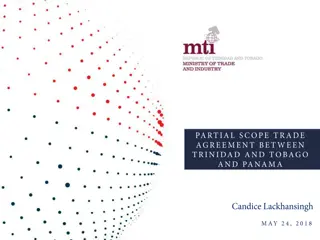Overview of Chronic Inflammation: Causes, Effects, and Patterns
Chronic inflammation, a prolonged inflammatory process lasting weeks to years, involves a complex interplay of cells and tissue changes leading to fibrosis. This type of inflammation can arise from persistent infections by microbes or immune-mediated inflammatory diseases. Understanding the causes, effects, and patterns of chronic inflammation is crucial for managing various conditions associated with it.
Download Presentation

Please find below an Image/Link to download the presentation.
The content on the website is provided AS IS for your information and personal use only. It may not be sold, licensed, or shared on other websites without obtaining consent from the author.If you encounter any issues during the download, it is possible that the publisher has removed the file from their server.
You are allowed to download the files provided on this website for personal or commercial use, subject to the condition that they are used lawfully. All files are the property of their respective owners.
The content on the website is provided AS IS for your information and personal use only. It may not be sold, licensed, or shared on other websites without obtaining consent from the author.
E N D
Presentation Transcript
Foundation Block, Pathology INFLAMMATION AND REPAIR Lecture 4 Chronic inflammation Systemic effect of inflammation Dr. Maha Arafah Associate Professor Department of Pathology King Khalid University Hospital and King Saud University Email: marafah@ksu.edu.sa marafah @hotmail.com Oct 2016
Objectives 1. Define chronic inflammation with emphasis on causes, nature of the inflammatory response, and tissue changes. 2. Compare and contrast the clinical settings in which different types of inflammatory cells (eosinophils, macrophages, and lymphocytes) accumulate in tissues. 3. Describe the systemic manifestations of inflammation and their general physiology, including fever, leukocyte left shift, and acute phase reactants. 2
1. Define chronic inflammation, its causes, effects and patterns CHRONIC INFLAMMATION Inflammation of prolonged duration (weeks to years) in which continuing inflammation, tissue injury, and healing, often by fibrosis, proceed simultaneously
1. Define chronic inflammation, its causes, effects and patterns CHRONIC INFLAMMATION It is slow evolving (weeks to months) resulting into fibrosis The essential changes are: 1. Absence of polymorphs (natural life span of 1 3 days); the appearance of macrophages, lymphocytes and often plasma cells 2. Proliferation of vascular endothelium by budding formation of new capillaries (angiogenesis). 3. Proliferation of fibroblasts with collagen production leading to Fibrosis.
1. Define chronic inflammation, its causes, effects and patterns Chronic inflammation may arise in the following settings: 1. Persistent infections by microbes that are difficult to eradicate. These include : Mycobacterium tuberculosis Treponema pallidum (the causative organism of syphilis) certain viruses and fungi All of which tend to establish persistent infections and elicit a T lymphocyte-mediated immune response called delayed-type hypersensitivity.
1. Define chronic inflammation, its causes, effects and patterns Chronic inflammation may arise in the following settings: 2. Immune-mediated inflammatory diseases (hypersensitivity diseases): Diseases that are caused by excessive and inappropriate activation of the immune system leading to autoimmune diseases. e.g. Rheumatoid arthritis inflammatory bowel disease psoriasis or Immune responses against common environmental substances that cause allergic diseases, such as bronchial asthma.
1. Define chronic inflammation, its causes, effects and patterns Chronic inflammation may arise in the following settings: 3. Prolonged exposure to potentially toxic agents. Examples are nondegradable exogenous materials such as inhaled particulate silica, which can induce a chronic inflammatory response in the lungs (silicosis) Endogenous agents such as cholesterol crystals, which may contribute to atherosclerosis
1. Define chronic inflammation, its causes, effects and patterns Chronic inflammation may arise in the following settings: 4. Mild forms of chronic inflammation may be important in the pathogenesis of many diseases Such diseases include: neurodegenerative disorders such as Alzheimer disease atherosclerosis metabolic syndrome and the associated type 2 diabetes, and some forms of cancer in which inflammatory reactions promote tumor development
1. Define chronic inflammation, its causes, effects and patterns CHRONIC INFLAMMATION Characterized by a 3 different set of reactions: 1. Infiltration with mononuclear cells, including: i. Macrophages ii. Lymphocytes iii. Plasma cells 2. Tissue destruction, largely induced by the products of the inflammatory cells 3. Repair, involving new vessel proliferation (angiogenesis) and fibrosis Acute inflammation is distinguished by vascular changes, edema, and a predominantly neutrophilic infiltrate
1. Define chronic inflammation, its causes, effects and patterns Lung chronic inflammation Lung acute inflammation
1. Define chronic inflammation, its causes, effects and patterns Chronic inflammation patterns Chronic non specific inflammation Features of chronic inflammation Examples: Foreign material, e.g. silicates, including asbestos. Auto-immune diseases, e.g. auto-immune thyroiditis Chronic granulomatous inflammation Chronic inflammation in which modified macrophages (epithelioid cells) accumulate in small clusters surrounded by lymphocytes. The small clusters are called: (GRANULOMAS) Example: TUBERCULOSIS
1. Define chronic inflammation, its causes, effects and patterns 2. Different types of inflammatory cells accumulate in tissues Cells in Chronic inflammation Complex interactions between several cell populations and their secreted mediators. Mediated by the interaction of monocyte macrophages with T and B lymphocyte, plasma cells and others
1. Define chronic inflammation, its causes, effects and patterns 2. Different types of inflammatory cells accumulate in tissues Macrophages In tissue: the liver (Kupffer cells) spleen and lymph nodes (sinus histiocytes) central nervous system (microglial cells) and lungs (alveolar macrophages) In blood: monocytes Under the influence of adhesion molecules and chemokines, they migrate to a site of injury within 24 to 48 hours after the onset of acute inflammation (macrophages)
2. Different types of inflammatory cells accumulate in tissues mononuclear phagocyte system monocytes begin to emigrate into extravascular tissues quite early in acute inflammation and within 48 hours they may constitute the predominant cell type
1. Define chronic inflammation, its causes, effects and patterns 2. Different types of inflammatory cells accumulate in tissues MONONUCLEAR CELL INFILTRATION Macrophages Macrophages may be activated by a variety of stimuli, including cytokines (e.g., IFN- ) secreted by sensitized T lymphocytes and by NK cells bacterial endotoxins
1. Define chronic inflammation, its causes, effects and patterns 2. Different types of inflammatory cells accumulate in tissues The roles of activated macrophages in chronic inflammation injurious agents such as microbes to initiate the process of repair secrete mediators of inflammation, such as cytokines (TNF, IL-1, chemokines, and eicosanoids). display antigens to T lymphocytes and respond to signals from T cells, thus setting up a feedback loop It is responsible for much of the tissue injury in chronic inflammation to eliminate
1. Define chronic inflammation, its causes, effects and patterns 2. Different types of inflammatory cells accumulate in tissues Macrophages In chronic inflammation, macrophage accumulation persists, this is mediated by different mechanisms: Recruitment of monocytes from the circulation Local proliferation of macrophages Immobilization of macrophages 1. 2. 3. Collection of activated macrophages : GRANULOMA 17
1. Define chronic inflammation, its causes, effects and patterns 2. Different types of inflammatory cells accumulate in tissues CELLS IN CHRONIC INFLAMMATION Lymphocytes Both T & B Lymphocytes migrates into inflammation site
1. Define chronic inflammation, its causes, effects and patterns 2. Different types of inflammatory cells accumulate in tissues Lymphocytes B lymphocytes may develop into plasma cells, which secrete antibodies T lymphocytes are activated to secrete cytokines: CD4+ T lymphocytes promote inflammation and influence the nature of the inflammatory reaction
1. Define chronic inflammation, its causes, effects and patterns 2. Different types of inflammatory cells accumulate in tissues Cell-mediated immunity
2. Different types of inflammatory cells accumulate in tissues Subsets of helper T (TH) cells In response to stimuli (mainly cytokines) present at the time of antigen recognition, naive CD4+ T cells may differentiate into populations of effector cells that produce distinct sets of cytokines and perform different functions. IBD, inflammatory bowel disease MS, multiple sclerosis
2. Different types of inflammatory cells accumulate in tissues CD4+ helper T cells There are three subsets of CD4+ helper T cells : TH1 cells produce the cytokine IFN- , Function: activates macrophages in the classical pathway. TH2 cells secrete IL-4, IL-5, and IL-13 Function: recruit and activate eosinophils and are responsible for macrophage activation. TH17 cells secrete IL-17 and other cytokines Function: induce the secretion of chemokines responsible for recruiting neutrophils and monocytes into the reaction.
1. Define chronic inflammation, its causes, effects and patterns 2. Different types of inflammatory cells accumulate in tissues Activating and inhibitory receptors of natural killer (NK) cells Healthy cells express self class I MHC molecules, which are recognized by inhibitory receptors, thus ensuring that NK cells do not attack normal cells. In infected and stressed cells, class I MHC expression is reduced so that the inhibitory receptors are not engaged, and ligands for activating receptors are expressed. The result is that NK cells are activated and the infected cells are killed.
1. Define chronic inflammation, its causes, effects and patterns 2. Different types of inflammatory cells accumulate in tissues Humoral immunity Naive B lymphocytes recognize antigens, and under the influence of TH cells and other stimuli, the B cells are activated to proliferate and to differentiate into antibody-secreting plasma cells. Some of the activated B cells undergo heavy-chain class switching and affinity maturation, and some become long-lived memory cells. Antibodies of different heavy-chain classes (isotypes) perform different effector functions. Note that the antibodies shown are IgG; these and IgM activate complement; and the specialized functions of IgA (mucosal immunity) and IgE (mast cell and eosinophil activation) are not shown.
2. Different types of inflammatory cells accumulate in tissues Humoral immunity
2. Different types of inflammatory cells accumulate in tissues OTHER CELLS IN CHRONIC INFLAMMATION Plasma cells Lymphoid cell (Mature B cells) Common cell in chronic inflammation Primary source of antibodies Antibodies are important in inflammation e.g. neutralize antigen and clearance of foreign Ag
2. Different types of inflammatory cells accumulate in tissues Eosinophils are abundant in immune reactions mediated by IgE and in parasitic infections respond to chemotactic agents derived largely from mast cells Granules contain major basic protein: toxic to parasites and lead to lysis of mammalian epithelial cells
2. Different types of inflammatory cells accumulate in tissues Mast cells are widely distributed in connective tissues express on their surface the receptor that binds the Fc portion of IgE antibody the cells degranulate and release mediators, such as histamine and products of AA oxidation 28
3. systemic manifestations of inflammation Systemic effects of Inflammation Liver - IL-6, IL-1, TNF Acute phase proteins C-reactive protein Lipopolysaccharide binding protein Serum amyloid A a-2 macroglobulin Haptoglobin Ceruloplasmin fibrinogen Acute phase reaction/response - IL-1 and TNF Fever Malaise Anorexia Bone marrow - IL-1 + TNF Leukocytosis Lymphoid organs
3. systemic manifestations of inflammation Fever Produced in response to Pyrogens Types of Pyrogens: Exogenous pyrogens: Bacterial products Endogenous pyrogens: IL-1 and TNF Bacterial products stimulate leukocytes to release cytokines such as IL-1 and TNF that increase the enzymes (cyclooxygenases) that convert AA into prostaglandins.
3. systemic manifestations of inflammation Fever In the hypothalamus, the prostaglandins, especially PGE2, stimulate the production of neurotransmitters such as cyclic AMP, which function to reset the temperature set-point at a higher level. NSAIDs, including aspirin , reduce fever by inhibiting cyclooxygenase and thus blocking prostaglandin synthesis.
3. systemic manifestations of inflammation Leukocytosis Shift to left
3. systemic manifestations of inflammation Inflammation Systemic Manifestations Leukocytosis: WBC count climbs to 15,000 or 20,000 cells/ l most bacterial infection (Neutrophil) Lymphocytosis: Infectious mononucleosis, mumps, German measles Eosinophilia: bronchial asthma, hay fever, parasitic infestations Leukopenia: typhoid fever, infection with rickettsiae/protozoa
3. systemic manifestations of inflammation Elevation of C reactive protein
3. systemic manifestations of inflammation Increased erythrocyte sedimentation rate (ESR) The rise in fibrinogen causes erythrocytes to form stacks (rouleaux) that sediment more rapidly at unit gravity than do individual erythrocytes. (ESR) TNF IL-1 IL-6 Hepatic synthesis of some plasma proteins most notably fibrinogen Rapid agglutination of erythrocytes
3. systemic manifestations of inflammation Erythrocyte sedimentation rate (ESR)
Summary 1. Chronic inflammation is different from acute inflammation with respect to causes, nature of the inflammatory response, and tissue changes. 2. Different clinical settings associated with different types of inflammatory cells (eg, eosinophils, monocyte-macrophages, and lymphocytes) accumulate in the tissues. 3. The systemic manifestations of inflammation include fever, leukocyte left shift, and acute phase reactants. 39
Cell-mediated immunity Dendritic cells (DCs) capture microbial antigens from epithelia and tissues and transport the antigens to lymph nodes. During this process, the DCs mature, and express high levels of MHC molecules and costimulators. Naive T cells recognize MHC-associated peptide antigens displayed on DCs. The T cells are activated to proliferate and to differentiate into effector and memory cells, which migrate to sites of infection and serve various functions in cell-mediated immunity. CD4+ effector T cells of the TH1 subset recognize the antigens of microbes ingested by phagocytes, and activate the phagocytes to kill the microbes; other subsets of effector cells enhance leukocyte recruitment and stimulate different types of immune responses. CD8+ cytotoxic T lymphocytes (CTLs) kill infected cells harboring microbes in the cytoplasm. Some activated T cells remain in the lymphoid organs and help B cells to produce antibodies, and some T cells differentiate into long-lived memory cells.























